Sizing of a Plug-In Hybrid Electric Vehicle with the Hybrid Energy Storage System
Abstract
:1. Introduction
2. Modeling and Control Strategy
2.1. Vehicle Configuration
2.2. Model
2.2.1. Battery Model
2.2.2. Supercapacitor Model
2.3. Hybrid Drive Control Strategy
2.4. Hybrid Energy Storage System Control Strategy
3. PHEV Component Sizing Optimization
PSO Solution
4. Optimization Results
4.1. Effect of Supercapacitors on Component Sizing
4.2. Effect of Driving Cycle on Component Sizing
5. Conclusions
- (1)
- The drivetrain cost of an HESS with a Ni-MH battery is reduced by up to 12.21% when compared to a HESS with Li-ion battery. Compared to the results from theoretical analysis, the drivetrain cost optimized by PSO is reduced by 8.79%.
- (2)
- After adding the supercapacitor to the energy storage system, the parameters of the engine and motor slightly increased, and the initial cost is higher, but the supercapacitor can extend the battery life and thus the drivetrain cost is reduced by 12.34% compared to an energy storage system without supercapacitors.
- (3)
- In order to study the effect of a drive cycle on component sizing, choose three different drive cycles to optimize. The simulation results show that the parameters of the engine, motor, battery and supercapacitor are increased with the cycle aggressiveness, and the vehicle mass and drivetrain cost are higher.
Author Contributions
Funding
Institutional Review Board Statement
Informed Consent Statement
Data Availability Statement
Conflicts of Interest
References
- Dimitrova, Z.; Maréchal, F. Techno-economic design of hybrid electric vehicles using multi objective optimization techniques. Energy 2015, 91, 630–644. [Google Scholar] [CrossRef]
- Kamankesh, H.; Agelidis, V.G.; Kavousi-Fard, A. Optimal scheduling of renewable micro-grids considering plug-in hybrid electric vehicle charging demand. Energy 2016, 100, 285–297. [Google Scholar] [CrossRef]
- Singh, A.; Pattnaik, S. Design of a efficient power sharing strategy for a battery-ultracapacitor hybrid energy storage system. In Proceedings of the 2016 IEEE 1st International Conference on Power Electronics, Intelligent Control and Energy Systems (ICPEICES), Delhi, India, 4–6 July 2016; IEEE: Manhattan, New York, USA, 2016; pp. 1–5. [Google Scholar]
- Shen., J.; Khaligh., A. Design and real-time controller implementation for a battery-ultracapacitor hybrid energy storage system. IEEE Trans. Ind. Inform. 2017, 12, 1910–1918. [Google Scholar] [CrossRef]
- Deng, Y.; Li, J.; Li, T.; Zhang, J.; Yang, F.; Yuan, C. Life cycle assessment of high capacity molybdenum disulfide lithium-ion battery for electric vehicles. Energy 2017, 123, 77–88. [Google Scholar] [CrossRef]
- Gao, C.; Zhao, J.; Wu, J.; Hao, X. Optimal fuzzy logic based energy management strategy of battery/supercapacitor hybrid energy storage system for electric vehicles. In Proceedings of the 2016 12th World Congress on Intelligent Control and Automation (WCICA), Guilin, China, 12–15 June 2016; IEEE: Manhattan, New York, USA, 2016; pp. 98–102. [Google Scholar] [CrossRef]
- Hajiaghasi, S.; Salemnia, A.; Hamzeh, M. Hybrid energy storage system for microgrids applications: A review. J. Energy Storage 2019, 21, 543–570. [Google Scholar] [CrossRef]
- Huang, Y.; Wang, H.; Khajepour, A.; Li, B.; Ji, J.; Zhao, K.; Hu, C. A review of power management strategies and component sizing methods for hybrid vehicles. Renew. Sustain. Energy Rev. 2018, 96, 132–144. [Google Scholar] [CrossRef]
- Yang, Y.; Pei, H.; Hu, X.; Liu, Y.; Hou, C.; Cao, D. Fuel economy optimization of power split hybrid vehicles: A rapid dynamic programming approach. Energy 2019, 166, 929–938. [Google Scholar] [CrossRef]
- Tran, M.-K.; Akinsanya, M.; Panchal, S.; Fraser, R.; Fowler, M. Design of a Hybrid Electric Vehicle Powertrain for Performance Optimization Considering Various Powertrain Components and Configurations. Vehicles 2020, 3, 20–32. [Google Scholar] [CrossRef]
- Guo, H.; Sun, Q.; Wang, C.; Wang, Q.; Lu, S. A systematic design and optimization method of transmission system and power management for a plug-in hybrid electric vehicle. Energy 2018, 148, 1006–1017. [Google Scholar] [CrossRef]
- Madanipour, V.; Montazeri-Gh, M.; Mahmoodi-K, M. Optimization of the component sizing for a plug-in hybrid electric vehicle using a genetic algorithm. Proc. Inst. Mech. Eng. Part D J. Automob. Eng. 2015, 230, 692–708. [Google Scholar] [CrossRef]
- Madanipour, V.; Montazeri-Gh, M.; Mahmoodi-K, M. Multi-objective component sizing of plug-in hybrid electric vehicle for optimal energy management. Clean Technol. Environ. Policy 2016, 18, 1189–1202. [Google Scholar] [CrossRef]
- Wu, X.; Hu, X.; Yin, X.; Li, L.; Zeng, Z.; Pickert, V. Convex programming energy management and components sizing of a plug-in fuel cell urban logistics vehicle. J. Power Sources 2019, 423, 358–366. [Google Scholar] [CrossRef]
- Murgovski, N.; Johannesson, L.; Sjöberg, J.; Egardt, B. Component sizing of a plug-in hybrid electric powertrain via convex optimization. Mechatronics 2012, 22, 106–120. [Google Scholar] [CrossRef] [Green Version]
- Pourabdollah, M.; Murgovski, N.; Grauers, A.; Egardt, B. Optimal Sizing of a Parallel PHEV Powertrain. IEEE Trans. Veh. Technol. 2013, 62, 2469–2480. [Google Scholar] [CrossRef] [Green Version]
- Bai, Y.; Li, J.; He, H.; Dos Santos, R.C.; Yang, Q. Optimal Design of a Hybrid Energy Storage System in a Plug-In Hybrid Electric Vehicle for Battery Lifetime Improvement. IEEE Access 2020, 8, 142148–142158. [Google Scholar] [CrossRef]
- Song, Z.; Zhang, X.; Li, J.; Hofmann, H.; Ouyang, M.; Du, J. Component sizing optimization of plug-in hybrid electric vehicles with the hybrid energy storage system. Energy 2018, 144, 393–403. [Google Scholar] [CrossRef]
- Jiang, H.; Xu, L.; Li, J.; Hu, Z.; Ouyang, M. Energy management and component sizing for a fuel cell/battery/supercapacitor hybrid powertrain based on two-dimensional optimization algorithms. Energy 2019, 177, 386–396. [Google Scholar] [CrossRef]
- Zhang, L.; Dorrell, D. Genetic Algorithm based optimal component sizing for an electric vehicle. In Proceedings of the IECON 2013-39th Annual Conference of the IEEE Industrial Electronics Society, Vienna, Austria, 10–13 November 2013; IEEE: Manhattan, New York, USA, 2013; pp. 7331–7336. [Google Scholar]
- Hegazy, O.; Van Mierlo, J. Particle swarm optimization for optimal powertrain component sizing and design of fuel cell hybrid electric vehicle. In Proceedings of the 12th International Conference on Optimization of Electrical and Electronic Equipment, Brasov, Romania, 20–22 May 2010; IEEE: Manhattan, New York, USA, 2010; pp. 601–609. [Google Scholar] [CrossRef]
- Wasbari, F.; Bakar, R.; Gan, L.; Tahir, M.; Yusof, A.A. A review of compressed-air hybrid technology in vehicle system. Renew. Sustain. Energy Rev. 2017, 67, 935–953. [Google Scholar] [CrossRef] [Green Version]
- Song, Z.; Hofmann, H.; Li, J.; Han, X.; Zhang, X.; Ouyang, M. A comparison study of different semi-active hybrid energy storage system topologies for electric vehicles. J. Power Sources 2015, 274, 400–411. [Google Scholar] [CrossRef]
- Zeng, H.; Gong, W. Simulation and Redevelopment of Electric Vehicle in Advisor 2002, 2nd ed.; China Machine Press: Beijing, China, 2002; pp. 252–266. [Google Scholar]
- Mauler, L.; Duffner, F.; Zeier, W.G.; Leker, J. Battery cost forecasting: A review of methods and results with an outlook to 2050. Energy Environ. Sci. 2021, 14, 4712–4739. [Google Scholar] [CrossRef]
- Wu, X.; Cao, B.; Li, X.; Xu, J.; Ren, X. Component sizing optimization of plug-in hybrid electric vehicles. Appl. Energy 2011, 88, 799–804. [Google Scholar] [CrossRef]
- Song, C.; Zhou, F.; Xiao, F.; Chang, C.; Shao, Y. Parameter matching of on-board hybrid energy storage system using NSGA-II algorithm. J. Jilin Univ. 2017, 47, 1336–1343. [Google Scholar]
- de Almeida, S.C.; Kruczan, R. Effects of drivetrain hybridization on fuel economy, performance and costs of a fuel cell hybrid electric vehicle. Int. J. Hydrogen Energy 2021, 46, 39404–39414. [Google Scholar] [CrossRef]
- Liu, C.; Wang, Y.; Chen, Z. Degradation model and cycle life prediction for lithium-ion battery used in hybrid energy storage system. Energy 2019, 166, 796–806. [Google Scholar] [CrossRef]
- Chen, X.; Chu, A.; Li, D.; Yuan, Y.; Fan, X.; Deng, Y. Development of the cycling life model of Ni-MH power batteries for hybrid electric vehicles based on real-world operating conditions. J. Energy Storage 2021, 34, 101999. [Google Scholar] [CrossRef]
- Song, Z.; Hofmann, H.; Li, J.; Han, X.; Ouyang, M. Optimization for a hybrid energy storage system in electric vehicles using dynamic programing approach. Appl. Energy 2015, 139, 151–162. [Google Scholar] [CrossRef]
- Elbes, M.; Alzubi, S.; Kanan, T.; Al-Fuqaha, A.; Hawashin, B. A survey on particle swarm optimization with emphasis on engineering and network applications. Evol. Intell. 2019, 12, 113–129. [Google Scholar] [CrossRef]

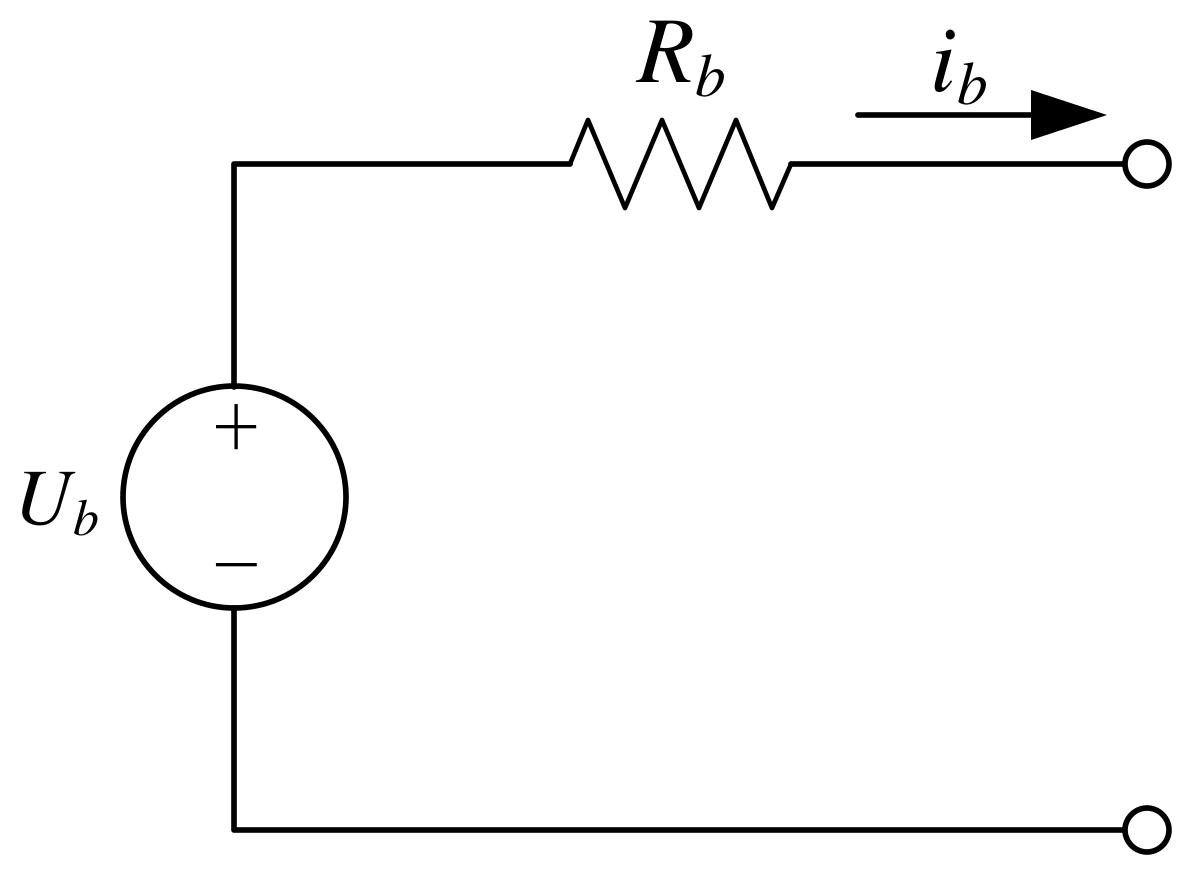

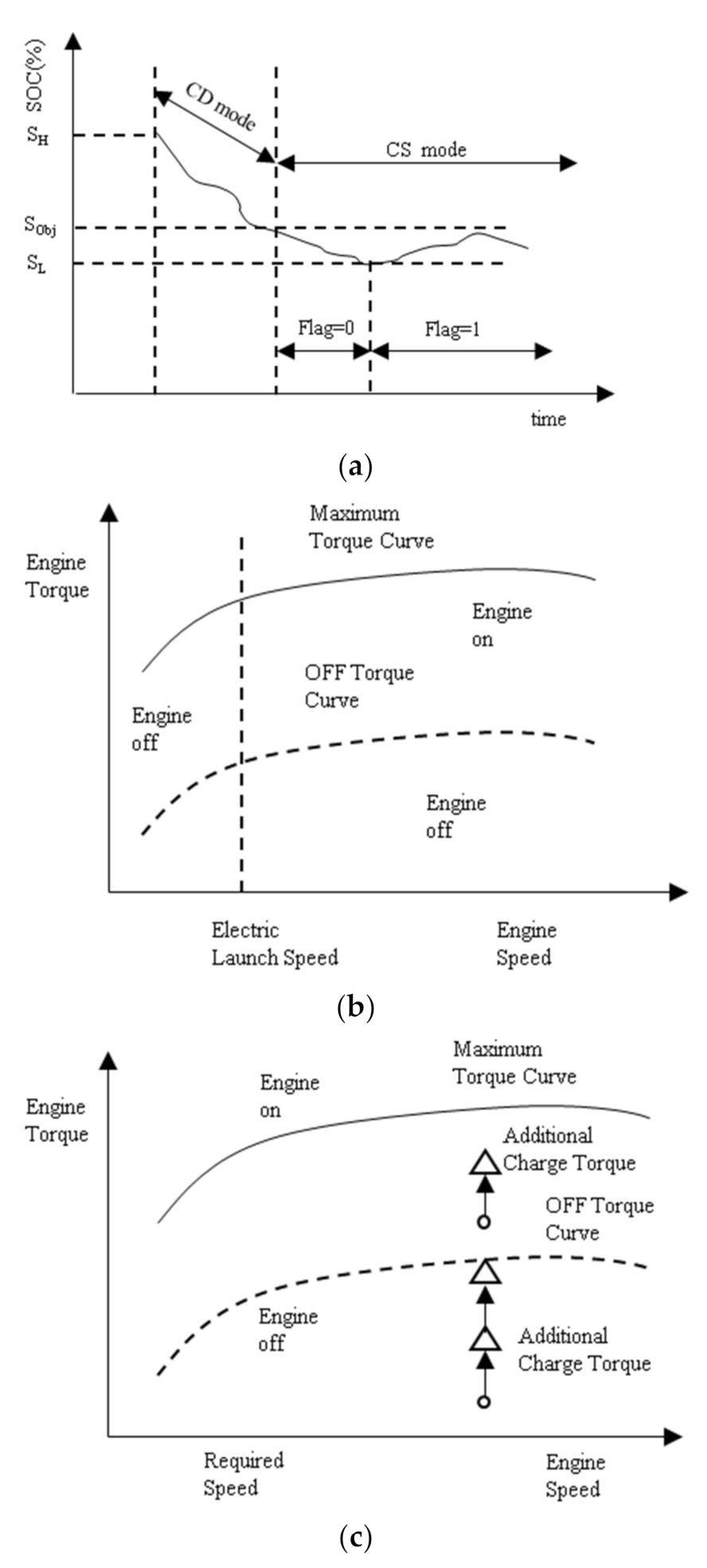

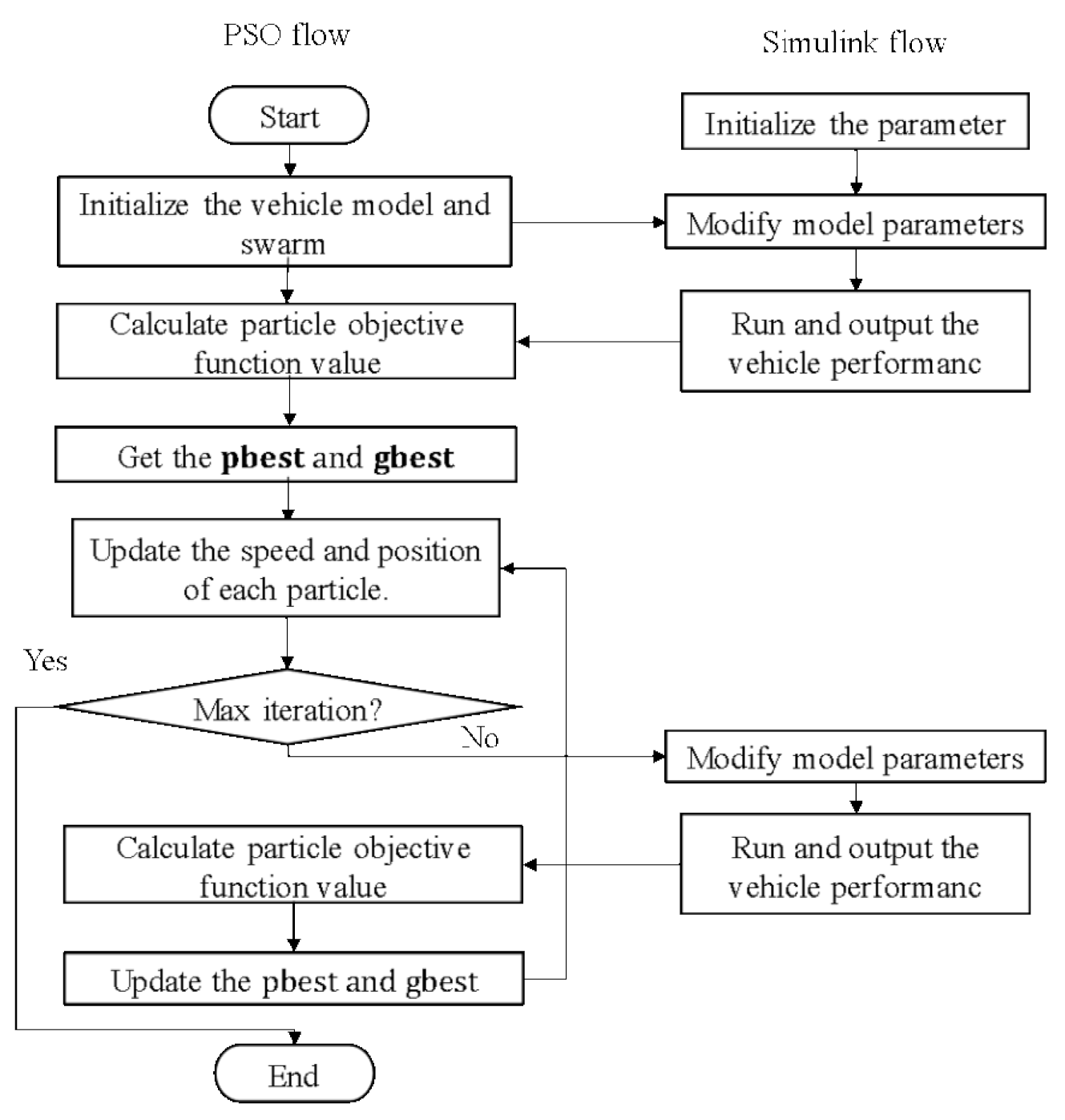
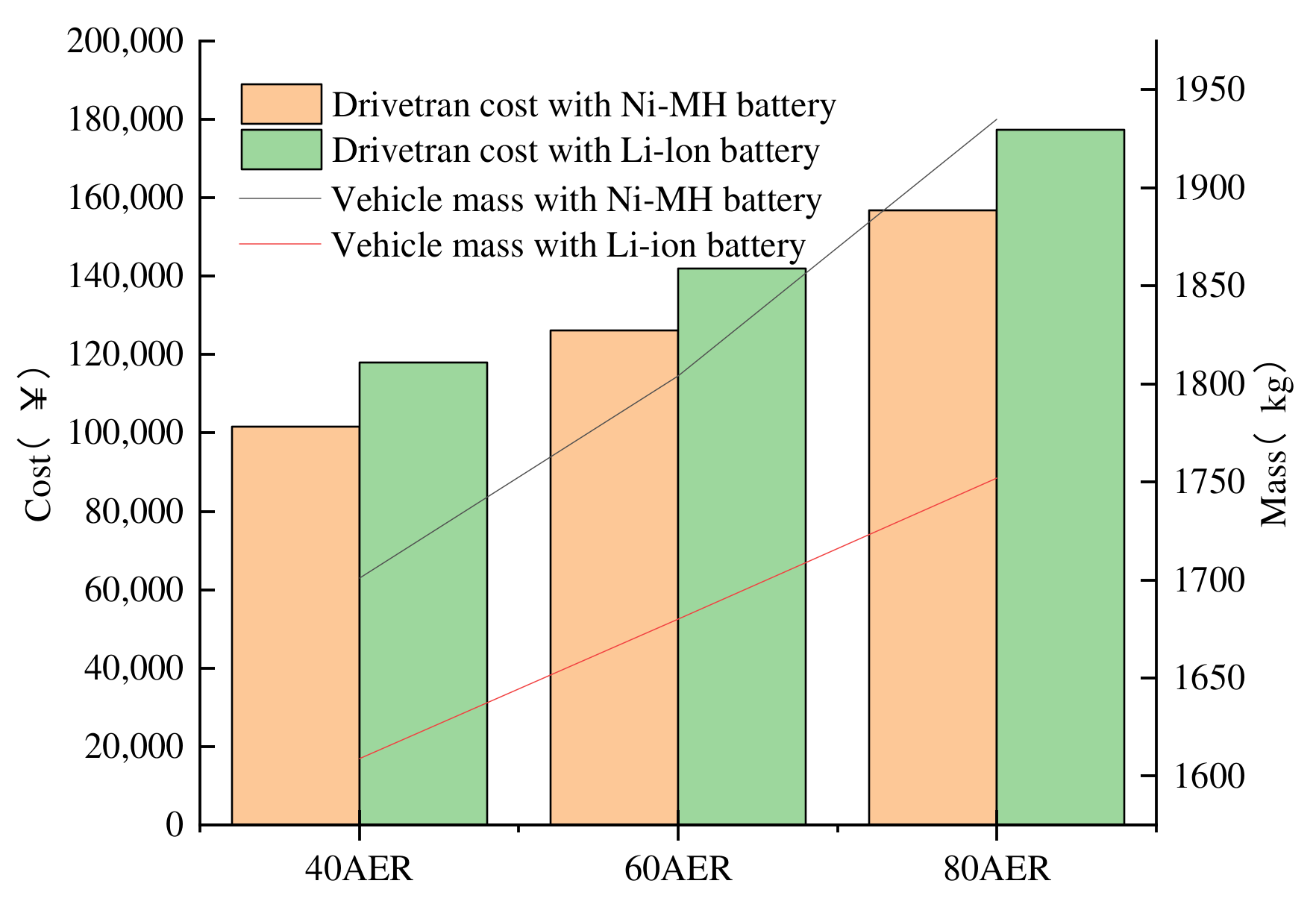

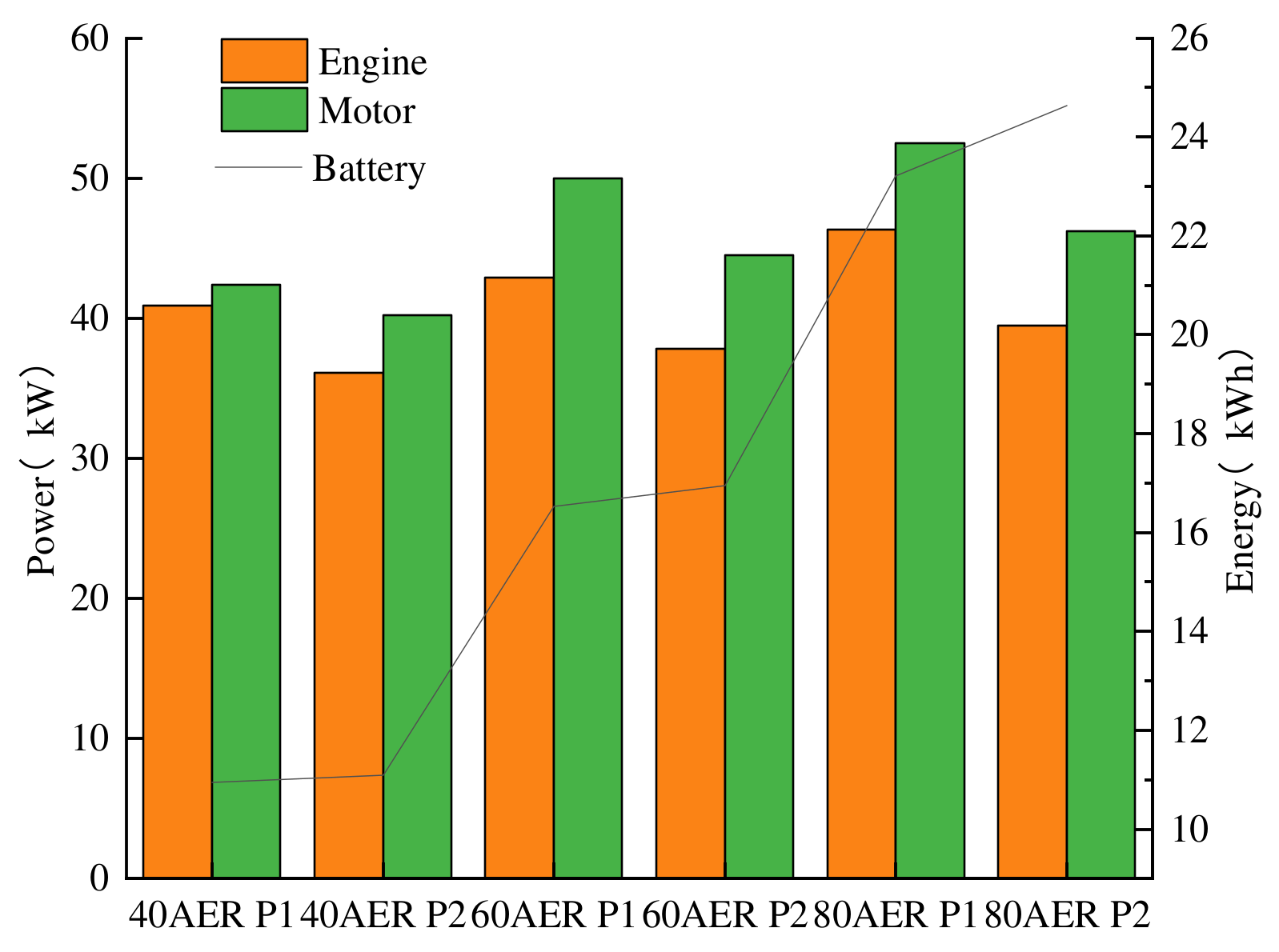


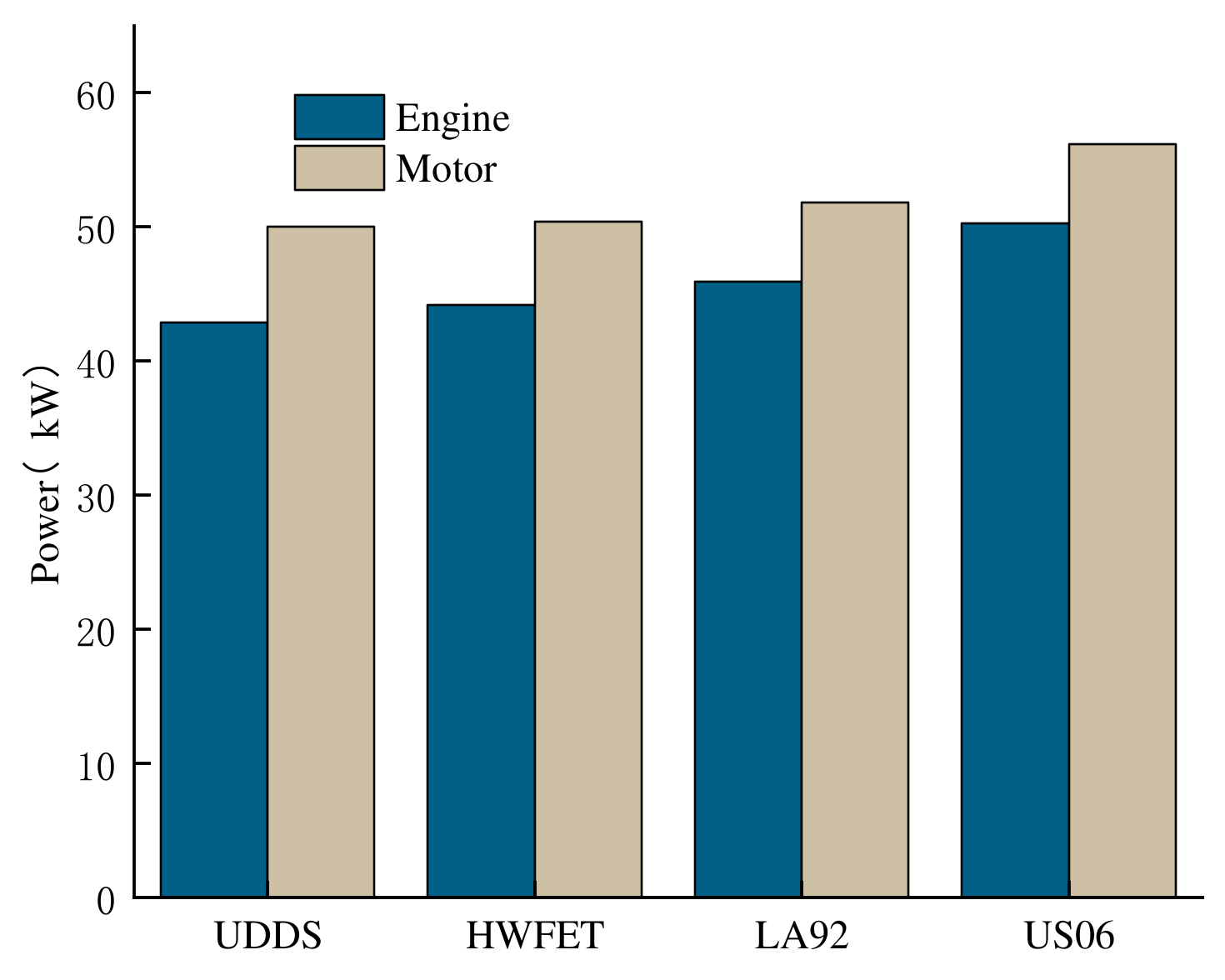

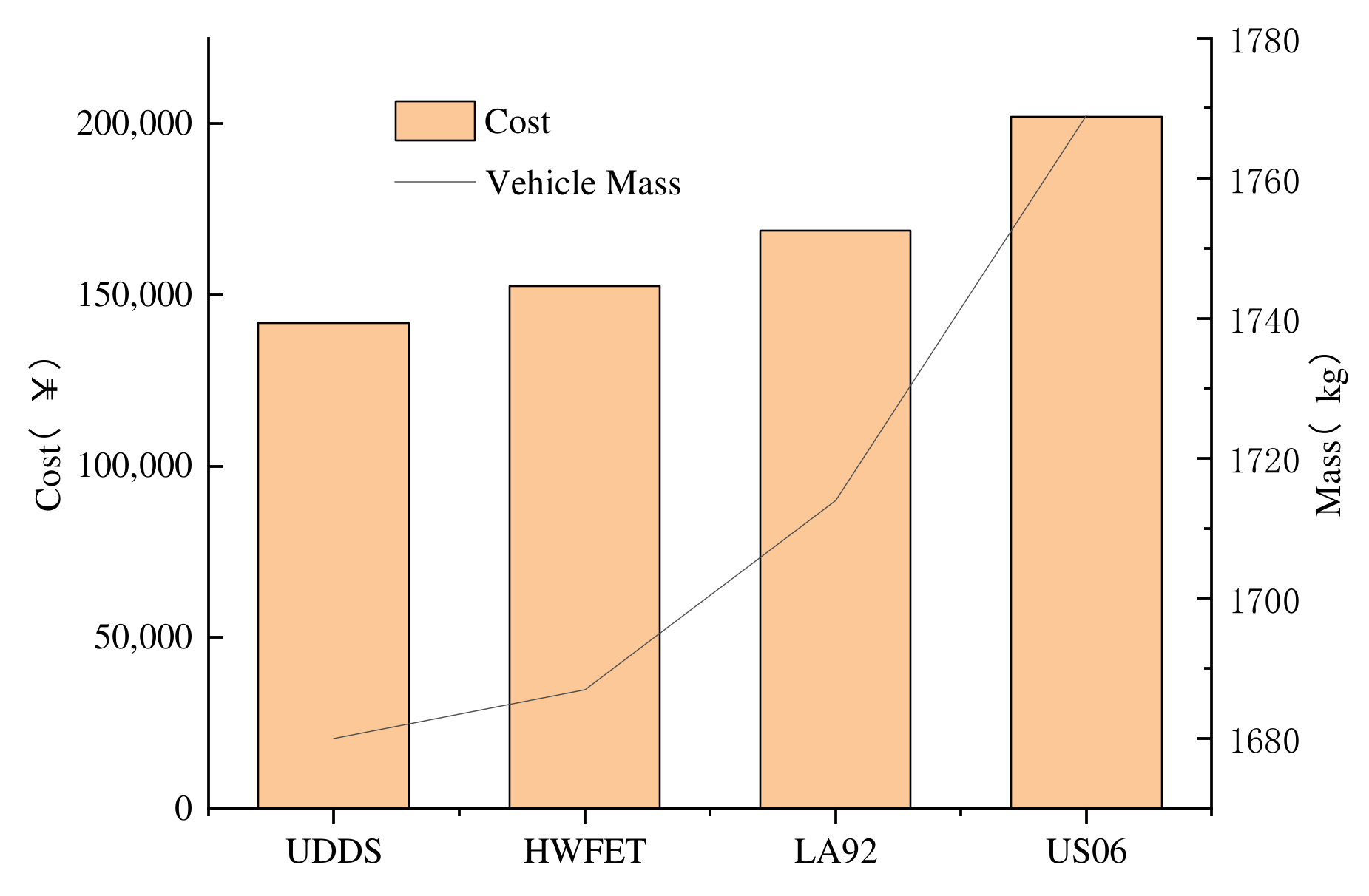
| Parameter | Value |
|---|---|
| Glider mass (kg) | 1150 |
| Rolling resistance coefficient | 0.009 |
| Air drag coefficient | 0.3 |
| Frontal area (m2) | 2.17 |
| Engine power (kW) | 41 |
| Motor power (kW) | 58 |
| Li-ion battery capacity (Ah/module) | 30 |
| Li-ion battery voltage (V/module) | 12 |
| Ni-MH battery capacity (Ah/module) | 28 |
| Ni-MH battery capacity (Ah/module) | 6 |
| Supercapacitors capacity (F/module) | 3000 |
| Supercapacitors voltage (V/module) | 2.5 |
| Optimization Variable | Lower Bound | Upper Bound |
|---|---|---|
| SIC | 0.8 | 1.8 |
| SEM | 0.6 | 1.5 |
| NB NUC | 25 65 | 65 120 |
| SBC (AER40 km) | 0.7 | 1.4 |
| (AER60 km) | 1.0 | 2.0 |
| (AER80 km) | 1.4 | 2.7 |
| SBC (AER40 km) | 0.8 | 1.8 |
| (AER60 km) | 1.1 | 2.1 |
| (AER60 km) | 1.4 | 2.5 |
| SUC (AER40 km) | 0.3 | 1.1 |
| (AER60 km) | 0.4 | 1.2 |
| (AER60 km) | 0.5 | 1.3 |
| Constraints | Description |
|---|---|
| Acceleration | 0–97 km/h (0–60 mph) ≤ 12 s |
| time | 64–97 km/h (40–60 mph) ≤ 5.3 s |
| 0–137 km/h (0–85 mph) ≤ 23.4 s 0–48.3 km/h (0–30 mph) ≤ 5 s in motor alone | |
| Gradeability | >30% (15 km/h) |
| Maximum speed | ≥170 km/h |
| Battery Type | AER (km) | SIC | SEM | NB | SBC | NUC | SUC |
|---|---|---|---|---|---|---|---|
| Li-ion | 40 | 0.9976 | 0.7310 | 32.6252 | 0.9207 | 115.7019 | 0.5414 |
| Ni-MH | 40 | 1.0975 | 0.8068 | 49.1521 | 1.3856 | 108.5634 | 0.6382 |
| Li-ion | 60 | 1.0463 | 0.8621 | 29.7014 | 1.5304 | 110.2505 | 0.6495 |
| Ni-MH | 60 | 1.1926 | 0.9155 | 49.0465 | 2.0753 | 108.0355 | 0.6995 |
| Li-ion | 80 | 1.1293 | 0.9052 | 35.0756 | 1.8425 | 102.3658 | 0.7492 |
| Ni-MH | 80 | 1.3121 | 0.9810 | 60.8873 | 2.3406 | 108.6984 | 0.8256 |
| Battery Type | AER (km) | Mass (kg) | Engine Power (kW) | Motor Power (kW) | Battery Capacity (Ah) | Battery Energy (kWh) | Supercapacitor Energy (Wh) | Drivetrain Cost (CNY) |
|---|---|---|---|---|---|---|---|---|
| Li-ion | 40 | 1609 | 40.9 | 42.4 | 27.6 | 10.94 | 351 | 118,013 |
| Ni-MH | 40 | 1701 | 45.0 | 46.8 | 38.8 | 11.44 | 386 | 101,525 |
| Li-ion | 60 | 1680 | 42.9 | 50.0 | 45.9 | 16.53 | 401 | 141,862 |
| Ni-MH | 60 | 1804 | 48.9 | 53.1 | 58.1 | 17.08 | 415 | 126,163 |
| Li-ion | 80 | 1752 | 46.3 | 52.5 | 55.3 | 23.21 | 432 | 177,401 |
| Ni-MH | 80 | 1935 | 53.8 | 56.9 | 65.5 | 23.94 | 499 | 156,829 |
| AER | Engine (kW) | Motor Energy (kW) | Battery Energy (kWh) | Supercapacitor Energy (Wh) | Mass (kg) | Drivetrain Cost (CNY) |
|---|---|---|---|---|---|---|
| 40 | 54.2 | 57.0 | 11.26 | 362 | 1671 | 123,706 |
| 60 | 54.7 | 61.8 | 17.21 | 429 | 1742 | 161,792 |
| 80 | 55.1 | 64.6 | 23.62 | 458 | 1802 | 193,958 |
Publisher’s Note: MDPI stays neutral with regard to jurisdictional claims in published maps and institutional affiliations. |
© 2022 by the authors. Licensee MDPI, Basel, Switzerland. This article is an open access article distributed under the terms and conditions of the Creative Commons Attribution (CC BY) license (https://creativecommons.org/licenses/by/4.0/).
Share and Cite
Tu, J.; Bai, Z.; Wu, X. Sizing of a Plug-In Hybrid Electric Vehicle with the Hybrid Energy Storage System. World Electr. Veh. J. 2022, 13, 110. https://doi.org/10.3390/wevj13070110
Tu J, Bai Z, Wu X. Sizing of a Plug-In Hybrid Electric Vehicle with the Hybrid Energy Storage System. World Electric Vehicle Journal. 2022; 13(7):110. https://doi.org/10.3390/wevj13070110
Chicago/Turabian StyleTu, Jian, Zhifeng Bai, and Xiaolan Wu. 2022. "Sizing of a Plug-In Hybrid Electric Vehicle with the Hybrid Energy Storage System" World Electric Vehicle Journal 13, no. 7: 110. https://doi.org/10.3390/wevj13070110
APA StyleTu, J., Bai, Z., & Wu, X. (2022). Sizing of a Plug-In Hybrid Electric Vehicle with the Hybrid Energy Storage System. World Electric Vehicle Journal, 13(7), 110. https://doi.org/10.3390/wevj13070110





